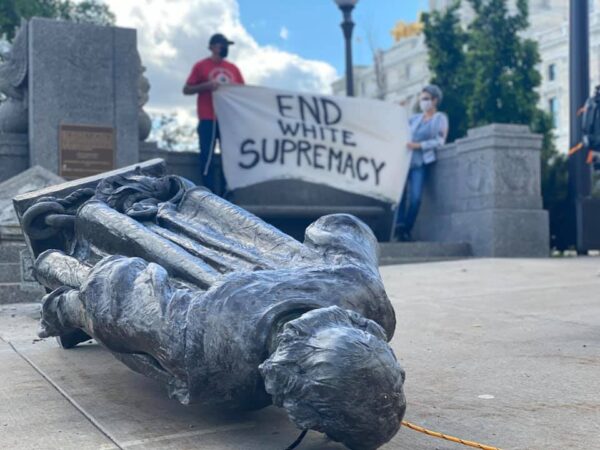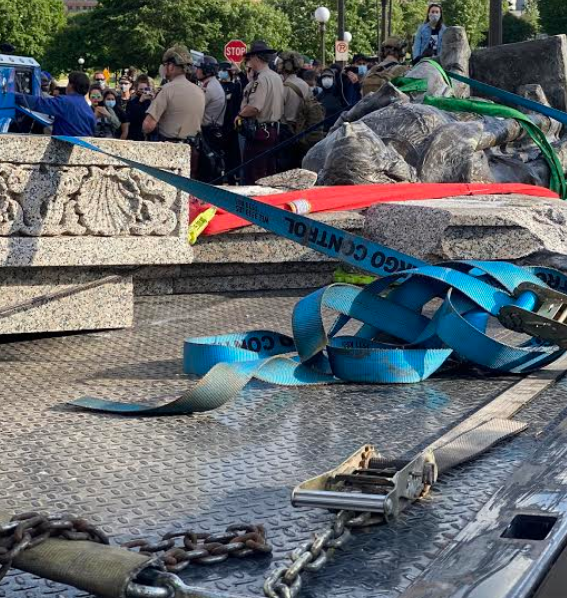
- Details
- By Native News Online Staff
ST. PAUL, Minn. — A wave of repercussions caused by the public's anger of George Floyd's death, who was murdered by Minneapolis police officers, is leading to the removal of controversial statues from public spaces across the country.
On Wednesday afternoon, a 10-foot tall bronze Christopher Columbus statue was taken down on the east side of the Minnesota State Capitol in St. Paul, Minnesota by members of the American Indian Movement (AIM).
It was the second Columbus statue taken down in as many days. On Tuesday night, a Columbus statue was torn down and thrown in a lake in Richmond, Virginia.
Columbus is no hero to American Indians and considered part of a false narrative of written American history.
On Wednesday morning, rumors were posted on social media that AIM members were going to take down the Columbus statue at the State Capitol. As people gathered on Wednesday afternoon, Minnesota State Police showed up with rifles. American Indians showed up with drums and rope.
By the end of the business day - around 5 pm - AIM put a rope around the neck of the statue that was erected in 1931 and toppled it.
AIM members have wanted the statue removed for decades.
“This is to honor our ancestors and the women who started to go missing since Columbus landed,” said organizer Mike Forcia, Bad River Band of Lake Superior Chippewa.
There were no arrests on Wednesday, but Forcia was informed he would be arrested at a later date.
Late Wednesday, Minnesota Lt. Governor Peggy Flanagan, who is a dual citizen of the White Earth Nation, voiced her opinion on the statue's removal on her Twitter account.
"I can't say I'm sad the statue of Christopher Columbus is gone. I'm not," she wrote. "All Minnesotans should feel welcome at the Minnesota State Capitol, and our state is long overdue for a hard look at the symbols, statues, and icons that were created without the input of many our communities."


To some, Wednesday toppling of the Columbus statue is just the beginning to changing the American history narrative.
“That’s just a tiny drop in the bucket,” Suzie Crow (Crow Creek Dakota) stated. “We still have all the history books and the references to go in this battle.”
Levi Rickert contributed to this story from Grand Rapids, Michigan.

 The Columbus statue was hoisted onto a flatbed truck and hauled away to an undisclosed location.
The Columbus statue was hoisted onto a flatbed truck and hauled away to an undisclosed location.
More Stories Like This
Native News Weekly (August 25, 2024): D.C. BriefsUS Presidents in Their Own Words Concerning American Indians
Federal Court Dismisses Challenge to NY Indigenous Mascot Ban
Sen. Angus King Warns of ‘Whitewashing’ History in National Parks Under Trump Administration
Final Call for Donations as CRYP’s 2025 Toy Drive Nears the Finish Line
Help us defend tribal sovereignty.
At Native News Online, our mission is rooted in telling the stories that strengthen sovereignty and uplift Indigenous voices — not just at year’s end, but every single day.
Because of your generosity last year, we were able to keep our reporters on the ground in tribal communities, at national gatherings and in the halls of Congress — covering the issues that matter most to Indian Country: sovereignty, culture, education, health and economic opportunity.
That support sustained us through a tough year in 2025. Now, as we look to the year ahead, we need your help right now to ensure warrior journalism remains strong — reporting that defends tribal sovereignty, amplifies Native truth, and holds power accountable.
 The stakes couldn't be higher. Your support keeps Native voices heard, Native stories told and Native sovereignty defended.
The stakes couldn't be higher. Your support keeps Native voices heard, Native stories told and Native sovereignty defended.
Stand with Warrior Journalism today.
Levi Rickert (Potawatomi), Editor & Publisher

